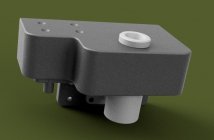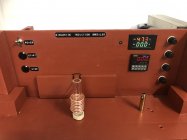// Power
int PB_OnOff = 34; // Power PB
int PwrON = 35; // Power LED
// Annealing
int PB_Annl = 36; // Annealing PB
int PwrAN = 37; // Annealing LED
// Mode Sel Switch
int PinONE = 30; // Sel Switch - TEST, ONE, AUTO
int PinAUTO = 31; // Sel Switch - TEST, ONE, AUTO
// Lift Sel Switch
int PinDN = 32; // Sel Switch Lift DN
int PinUP = 33; // Sel Switch Lift UP
// Traffic Lights
int PinGRN = 38; // Green
int PinYLO = 39; // Yelow
// Relays
int PwrR1 = 46; // Relay 1 Power Supply
int StepR = 47; // Relay 1 Step power select
int PwrR2 = 48; // Relay Anneal
// Analog reading
int PinV = A1; // Volts
int PinA = A2; // Amps
int PinIR = A3; // IR Sensor
// FUNCTIONS Declaration
void DropGate();
void SelSwitch();
void StartStop();
void TheLift(boolean Up);
void Anneal();
void BillBoard(int N);
void AnnSwitch(boolean ON);
void TempKeep();
boolean E_Stop();
// == GLOBAL VARABLES ==
boolean SysIni = true;
int Task = 0;
int AnnTime = 0;
int AnnCount = 0;
int SelSw = 0;
int Lvl = 0;
int T = 0;
int Steps = 585*2; //////int Steps = 200;
int Level[] = {18, 24, 30}; int LvlN = 3; // .284, .260, 6 mm
// Step Motor Library
#include <Stepper.h>
Stepper Lift(Steps, 8,10,9,11);
Stepper Gate(Steps, 8,10,9,11);
// Screen Display library
#include <LiquidCrystal_I2C.h>
#include <Wire.h>
#include <EEPROM.h>
LiquidCrystal_I2C lcd = LiquidCrystal_I2C(0x27, 20, 4);
// =============
// === setup ===
// =============
void setup() {
// Serial Port
Serial.begin(115200);
// Initiate the LCD:
lcd.init(); lcd.backlight();
// Initialize Memory
Lvl = EEPROM.read(10);
// EEPROM.write(10, 10); establishing reference level - one time only
// Start, Stop, Annealing
pinMode(PB_OnOff,INPUT_PULLUP); digitalWrite(PB_OnOff,HIGH); // Start/Stop Push Button
pinMode(PB_Annl, INPUT_PULLUP); digitalWrite(PB_Annl, HIGH); // Annealing Push Button
// Power Supply and Annealing - LED, Relays
pinMode(PwrON, OUTPUT); digitalWrite(PwrON, LOW); // ON/OFF LED / Relay 1
pinMode(PwrAN, OUTPUT); digitalWrite(PwrAN, LOW); // Annealing LED / Relay 2
// Selector Switches
pinMode(PinONE, INPUT); digitalWrite(PinONE, HIGH); // Sel Switch - TEST, ONE, AUTO
pinMode(PinAUTO, INPUT); digitalWrite(PinAUTO, HIGH); // Sel Switch - TEST, ONE, AUTO
pinMode(PinUP, INPUT_PULLUP); digitalWrite(PinUP, HIGH); // Sel Switch Lift UP
pinMode(PinDN, INPUT_PULLUP); digitalWrite(PinDN, HIGH); // Sel Switch Lift UP
// Traffic signals
pinMode(PinGRN, OUTPUT); digitalWrite(PinGRN, LOW); // Trafic Signal Green
pinMode(PinYLO, OUTPUT); digitalWrite(PinYLO, LOW); // Trafic Signal Green
// Pwr Relays
pinMode(PwrR1, OUTPUT); digitalWrite(PwrR1, HIGH); // On/Off
pinMode(PwrR2, OUTPUT); digitalWrite(PwrR2, LOW); // Anneal
pinMode(StepR, OUTPUT); digitalWrite(StepR, HIGH); // Step Motor Pwr Select
// Step Motors
Lift.setSpeed(35); Gate.setSpeed(30);
}
// =================
// === Main Loop ===
// =================
void loop() {
// Inititializing
if (SysIni == true){
SysIni = false; // On Time execution
if (digitalRead(PinONE) == HIGH && digitalRead(PinAUTO) == LOW) {SelSw = 1;} // TEST
if (digitalRead(PinONE) == LOW && digitalRead(PinAUTO) == LOW) {SelSw = 2;} // ONES
if (digitalRead(PinONE) == LOW && digitalRead(PinAUTO) == HIGH){SelSw = 3;} // AUTO
int N = 0;
for (N = 0; N <= 3; N++){
BillBoard(N); SysIni = false;
}
}
// Volts
BillBoard(3);
// Task Assignment
if (digitalRead(PB_OnOff) == LOW) // Strat Stop
{Task = 1;}
if (digitalRead(PB_Annl) == LOW) // Annealing
{Task = 2;}
if (digitalRead(PinUP) == LOW) // Cartridge Lift Up
{Task = 3;}
if (digitalRead(PinDN) == LOW) // Cartridge Lift Dn
{Task = 4;}
// Monitor SelSw
SelSwitch(); // monotors TEST, ONE, AUTO Sel Sw.
// Do the Task
switch (Task){
case (1): StartStop() ; Task = 0; delay(250); break;
case (2): Anneal() ; Task = 0; delay(250); break;
case (3): TheLift(true); Task = 0; delay(10); break;
case (4): TheLift(false); Task = 0; delay(10); break;
}
for (int y = 8; y <= 11; ++y){digitalWrite(y, LOW);} // Deenergize the step motors
}
// ================
// ==== Anneal ====
// ================
void Anneal(){
int y=0; boolean InList=false;
// Anneal Time
BillBoard(1); // AUTO, ONESHOT
if (SelSw == 1) {AnnTime=6500;} // TEST
if (digitalRead(PwrON)==false) // No Power
{AnnTime = 0;}
// The LED and the Anneal Relay
AnnSwitch(true);
// Start Annealing
int bTime = millis(); int cTime = 0;
while (cTime<AnnTime){
cTime = millis()-bTime; T = cTime;
delay(100); BillBoard(3); // Show Count Down Time
if (E_Stop() == true){return;} // Interrupt Annealing
}
// Stop Annealing
AnnSwitch(false); DropGate();
++AnnCount; BillBoard(2);
// Traffic Signals
if (SelSw == 3){ // AUTO
digitalWrite(PinGRN, HIGH); cTime = 0; bTime = millis();
while (cTime<2000){ // Green Traffic
cTime = millis()-bTime;
if (E_Stop() == true){return;} // Stop Annealing
}
digitalWrite(PinGRN, LOW); cTime = 0; bTime = millis();
BillBoard(2);
while (cTime<2000){ // Green Traffic
cTime = millis()-bTime;
if (E_Stop() == true){return;} // Stop Annealing
digitalWrite(PinYLO, HIGH); delay(250);
if (E_Stop() == true){return;} // Stop Annealing
digitalWrite(PinYLO, LOW); delay(250);
}
Anneal(); // Anneal Again on AUTO
}
}
// =================
// === BillBoard ===
// =================
void BillBoard(int N) {
// Line 1 - "Tesla Oakley Annealing"
// Line 2 - Set Selected caliber or Level
// Line 3 - TEST, ONES, AUTO, COUNTS
// Line 4 - VOLTS, AMPS, TIMING
// Line 1 Variables
String sLvl = ""; int sVolt = 0; int sTime = 0; int y = 0; int S = 0;
// Line 2 Variables
String sMode = ""; boolean inList = false;
Lvl = EEPROM.read(10);
// Line 3 Variables
int V = 0; int A = 0;
// Is it on The List
for (y = 0; y < LvlN; ++y){
if (Level[y] == Lvl){inList = true; S = y; break;}
}
lcd.setCursor(0,N);
switch (N){
case 0:
lcd.print("Tesla Oakley Anneal"); break;
case 1:
AnnTime = 0;
if (inList == true && SelSw != 1){
switch (S){
case 0: sLvl = ".284 "; sVolt = 46; sTime = 3600; break;
case 1: sLvl = ".260 "; sVolt = 46; sTime = 4400; break;
case 2: sLvl = "6 mm "; sVolt = 40; sTime = 3800; break;
}
AnnTime = sTime;
lcd.print("Set: ");
lcd.print(sLvl);lcd.print(sVolt);lcd.print(" V ");
lcd.print(AnnTime/1000.0,1); lcd.print("s ");
}
if (inList == false || SelSw == 1){
lcd.print("Level "); lcd.print(Lvl); lcd.print(" ");
lcd.print(AnnTime/1000.0,1); lcd.print("s ");
}
break;
case 2: // Line 2
switch (SelSw){
case 1: sMode = "TEST "; AnnTime = 5000;
break;
case 2: sMode = "ONES ";
if (inList == false){AnnTime = 0;}break;
case 3: sMode = "AUTO ";
if (inList == false){AnnTime = 0;} break;
}
lcd.print("Mode: "); lcd.print(sMode);
lcd.print("Cnt "); lcd.print(AnnCount);
break;
case 3: // Line 3
V = 50.0*analogRead(PinV)/1023.0;
A = analogRead(PinA)-527; A = - 50*A/1023;
if(abs(V)<1){V=0;}
if (abs(A)<1) {A=0;}
lcd.print("Annl: ");
lcd.print(V);lcd.print(" V ");
lcd.print(A);lcd.print(" A ");
lcd.print(T/1000.0,1);lcd.print("s");
break;
}
}
// ===============
// === TheLift ===
// ===============
void TheLift(boolean Up) {
int y = 0;
// Obey Travel Limits or Pause at Next Cartridge Level
while (digitalRead(PinUP) == LOW || digitalRead(PinDN) == LOW){
if (Up == false && Lvl == 10){return;}
// Is it in the list?
for (y = 0; y < LvlN; ++y){
if(Level[y] == Lvl)
{BillBoard(1); delay(1000);break;}
}
// Spin it
digitalWrite(StepR, LOW);
if (Up == true) {Lift.step( Steps); ++Lvl;}
if (Up == false){Lift.step(-Steps); --Lvl;}
EEPROM.write(10, Lvl); BillBoard(1);
}
digitalWrite(StepR, HIGH);
}
// ====================
// ==== DROP_GATE =====
// ====================
void DropGate(){
int y; int Move = 227; // 15 degree Gate.setSpeed(30); Lift.setSpeed(35);
Gate.step(-Move); delay(1250);
Gate.step(Move); ;
for(y = 8; y<=11; ++y){digitalWrite(y, LOW);}
}
// =============
// == E-Stop ===
// =============
boolean E_Stop() {
boolean STOP = false;
boolean AnnON = false;
if (digitalRead(PwrR2)==HIGH)
{AnnON = true;}
if (digitalRead(PB_OnOff) == LOW) {
AnnSwitch(false); // Stop Annealing
if (AnnON == true)
{DropGate();}
digitalWrite(PinGRN, LOW);
digitalWrite(PinYLO, LOW);
STOP = true;
}
return STOP;
}
//====================
//==== START_STOP ====
//===================
void StartStop(){
if (digitalRead(PwrON)==LOW)
{digitalWrite(PwrON, HIGH);digitalWrite(PwrR1,LOW);return;}
if (digitalRead(PwrON)==HIGH)
{digitalWrite(PwrON, LOW);digitalWrite(PwrR1,HIGH); return;}
}
//====================
//==== SelSwitch ====
//===================
void SelSwitch(){
int S = 0;
if (digitalRead(PinONE) == HIGH && digitalRead(PinAUTO) == LOW) {S = 1;} // TEST
if (digitalRead(PinONE) == HIGH && digitalRead(PinAUTO) == HIGH){S = 2;} // ONES
if (digitalRead(PinONE) == LOW && digitalRead(PinAUTO) == HIGH) {S = 3;} // AUTO
if (digitalRead(PwrON) == HIGH){BillBoard(3);} // Show Volatage all the time
if(SelSw == S)
{return;}
if(SelSw != S)
{SelSw = S; AnnCount = 0; BillBoard(1);BillBoard(2);}
}
// =================
// === AnnSwitch ===
// =================
void AnnSwitch(boolean ON){
if (ON == true){
digitalWrite(PwrAN, HIGH); digitalWrite(PwrR2, HIGH); // Contactor and LED ON
}
if (ON == false){
digitalWrite(PwrAN, LOW); digitalWrite(PwrR2, LOW); // Contactor and LED OFF
}
}















